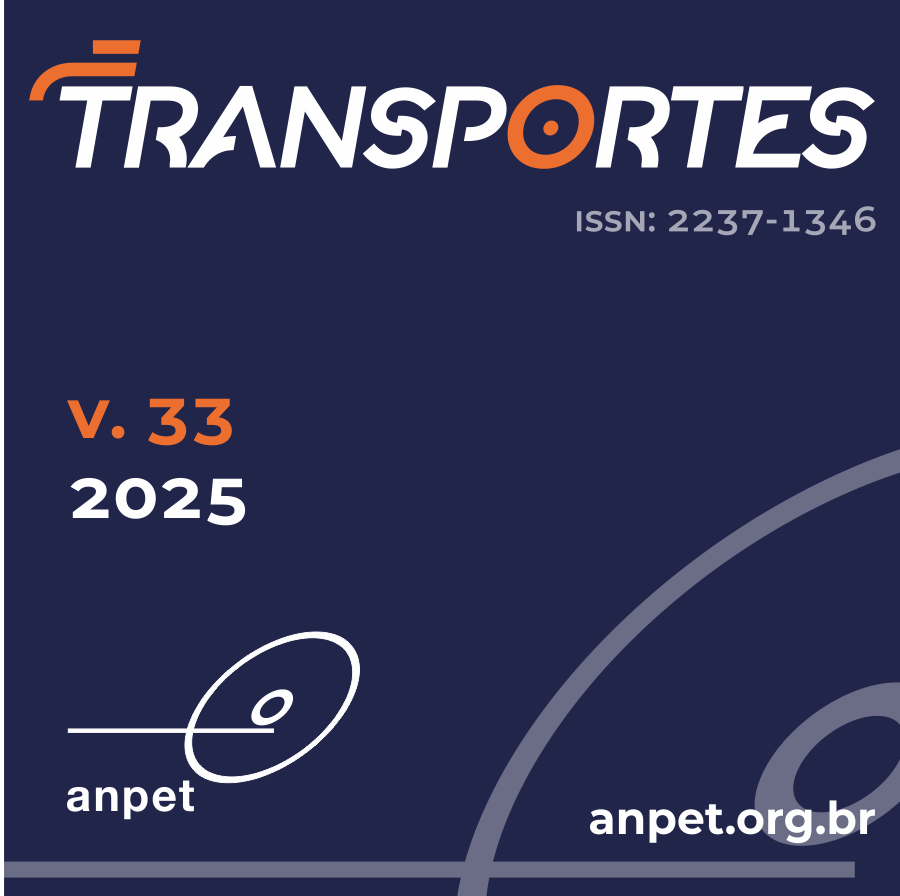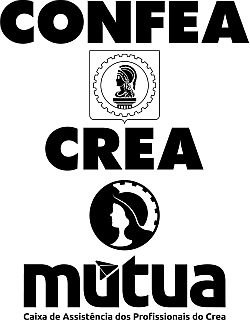Evaluation of indoor air quality in a laboratory setting during hot mix asphalt production
DOI:
https://doi.org/10.58922/transportes.v33.e3125Keywords:
Laboratory, Asphalt mixtures, Air qualityAbstract
This study aimed to characterize the emission of atmospheric pollutants during laboratory-scale asphalt mixture production, in order to generate knowledge about air quality in such settings and contribute with technical information within the Brazilian context. Experimentally, the following environmental parameters were monitored: air temperature, relative humidity, carbon dioxide (CO2), total suspended particles (TSP), particulate matter of 10 μm (PM10) and 2.5 μm (PM2.5), as well as metals (Ca, Mg, Zn, Ni, V, and Pb) and benzo(a)pyrene. The average concentrations observed during asphalt mixing were: 1153.2 μg/m3 of TSP; 244.0 μg/m3 of PM10; 161.5 μg/m3 of PM2.5; 5.8 ng/m3 of benzo(a)pyrene; 674 ppm of CO2; 105.8 μg/m3 of calcium (Ca); 63.6 μg/m3 of magnesium (Mg); and 3.81 μg/m3 of zinc (Zn). Lead (Pb), nickel (Ni), and vanadium (V) were not detected in the samples. Overall, the average concentrations of TSP, PM10, PM2.5, benzo(a)pyrene, Ca, Mg, and Zn exceeded the limits established by national and international standards for indoor environments.
Downloads
References
Abdullah, M.E.; M.R. Hainin; N.I.M. Yusoff et al. (2016) Laboratory evaluation on the characteristics and pollutant emissions of nanoclay and chemical warm mix asphalt modified binders. Construction & Building Materials, v. 113, p. 488-97. DOI: 10.1016/j.conbuildmat.2016.03.068. DOI: https://doi.org/10.1016/j.conbuildmat.2016.03.068
ABNT (2023) NBR 17037: Qualidade do Ar Interior em Ambientes Não Residenciais Climatizados Artificialmente. Rio de Janeiro: ABNT.
ABNT (2024) NBR 15220-3: Desempenho Térmico de Edificações – Parte 3: Zoneamento Bioclimático por Desempenho. Rio de Janeiro: ABNT.
Achternbosch, M.; K. Bräutigam; N. Hartlieb et al. (2005) Impact of the use of waste on trace element concentrations in cement and concrete. Waste Management & Research, v. 23, n. 4, p. 328-37. DOI: 10.1177/0734242X05056075. PMid:16200983. DOI: https://doi.org/10.1177/0734242X05056075
Alcântara, A.P.M.P.; J.P. Ribeiro; I.G.R. Segundo et al. (2023) Diagnóstico de emissões de poluentes atmosféricos na produção de misturas asfálticas. Transportes, v. 31, n. 3, p. 1-12. DOI: 10.58922/transportes.v31i3.2887. DOI: https://doi.org/10.58922/transportes.v31i3.2887
Alcântara, A.P.M.P.; J.P. Ribeiro; L.M. Barbosa et al. (2019) Avaliação da emissão de material particulado e dióxido de nitrogênio na usinagem de misturas asfálticas. In Anais do XXXIII Congresso de Pesquisa e Ensino em Transportes (Balneário Camboriú, SC). Balneário Camboriú: ANPET, p. 1841-1852.
Bernucci, L.B.; L.M.G. Motta; J.A.P. Ceratti et al. (2022) Pavimentação Asfáltica: Formação Básica para Engenheiros (2a ed.). Rio de Janeiro: ABEDA.
Branco, P.T.B.S.; S.I.V. Sousa; M.R. Dudzińska et al. (2024) A review of relevant parameters for assessing indoor air quality in educational facilities. Environmental Research, v. 261, p. 119713. DOI: 10.1016/j.envres.2024.119713. PMid:39094896. DOI: https://doi.org/10.1016/j.envres.2024.119713
Brasil, Agência Nacional de Vigilância Sanitária (2003) Resolução - RE nº 9: padrões referenciais de qualidade do ar interior, em ambientes climatizados artificialmente de uso público e coletivo. Diário Oficial da República Federativa do Brasil.
CETESB (2022) FIT – Ficha de Informação Toxicológica: Níquel, Vanádio e seus Compostos. São Paulo: Divisão de Toxicologia e Saúde Animal.
EPD (2025) Hong Kong Air Quality Objectives. Environmental Protection Department, The Government of Hong Kong Special Administrative Region. Available at: <https://www.epd.gov.hk/epd/english/environmentinhk/air/air_quality_objectives/air_quality_objectives.html> (accessed 06/27/2025).
European Union (2004) Directive 2004/107/EC of the European parliament and of the council of 15 December 2004 relating to Arsenic, Cadmium, Mercury, Nickel and Polycyclic Aromatic Hydrocarbons in Ambient Air. Official Journal of the European Union.
Gaudefroy, V.; D.L. Presti; L. Porot et al. (2022) Organic compounds evaluation from fumes generated in laboratory by bio-recycled asphalt mixtures. Journal of Testing and Evaluation, v. 50, n. 2, p. 920-7. DOI: 10.1520/JTE20210201. DOI: https://doi.org/10.1520/JTE20210201
Germin-Aizac, J.; A. Maitre; F. Balducci et al. (2023) Bitumen fumes and PAHs in asphalt road paving: emission characteristics, determinants of exposure and environmental impact. Environmental Research, v. 228, p. 115824. DOI: 10.1016/j.envres.2023.115824. PMid:37030408. DOI: https://doi.org/10.1016/j.envres.2023.115824
Gomes Neto, D.P.; H. Conceição; V.A.C. Lisboa et al. (2014) Influence of granitic aggregates from northeast Brazil on the alkali-aggregate reaction. Materials Research, v. 17, p. 51-8. DOI: 10.1590/S1516-14392014005000045. DOI: https://doi.org/10.1590/S1516-14392014005000045
Gomes, M.J.M. (2002) Ambiente e pulmão. Jornal de Pneumologia, v. 28, n. 5, p. 261-9. DOI: 10.1590/S0102-35862002000500004. DOI: https://doi.org/10.1590/S0102-35862002000500004
Han, S.; J. Lee and C. Baek (2023) Evaluation of emission characteristics and microstructure of particulate matters from excavation and restoration work on asphalt concrete pavement. Applied Sciences, v. 13, n. 1, p. 323. DOI: 10.3390/app13010323. DOI: https://doi.org/10.3390/app13010323
Hong Kong (2019) A Guide on Indoor Air Quality Certification Scheme for Offices and Public Places. Indoor Air Quality Management Group, The Government of the Hong Kong Special Administrative Region.
ISO (2016) EN ISO 374-1:2016 - Protective Gloves Against Dangerous Chemicals and Micro-Organisms – Part 1: Terminology and Performance Requirements for Chemical Risks. Geneva: ISO.
Jang, T.; Y. Kim; J. Won et al. (2018) The standards for recognition of occupational cancers related with polycyclic aromatic hydrocarbons (PAHs) in Korea. Annals of Occupational and Environmental Medicine, v. 30, n. 1, p. 13. DOI: 10.1186/s40557-018-0224-1. PMid:39541432. DOI: https://doi.org/10.1186/s40557-018-0224-1
Kharat, D.S. (2022) Emissions from hot mix asphalt plants and their impact on ambient air quality. Water, Air, and Soil Pollution, v. 233, n. 11, p. 464. DOI: 10.1007/s11270-022-05950-w. DOI: https://doi.org/10.1007/s11270-022-05950-w
Kitto, A.M.; M. Pirbazari; B.N. Badriyha et al. (1997) Emissions of volatile and semi-volatile organic compounds and particulate matter from hot asphalts. Environmental Technology, v. 18, n. 2, p. 121-38. DOI: 10.1080/09593331808616520. DOI: https://doi.org/10.1080/09593331808616520
Li, J.; Y. Qin; X. Zhang et al. (2024) Emission characteristics, environmental impacts, and health risks of volatile organic compounds from asphalt materials: a state-of-the-art review. Energy & Fuels, v. 38, n. 6, p. 4787-802. DOI: 10.1021/acs.energyfuels.3c04438. DOI: https://doi.org/10.1021/acs.energyfuels.3c04438
Lin, S.; W. Hung and Z. Leng. (2016) Air pollutant emissions and acoustic performance of hot mix asphalts. Construction & Building Materials, v. 129, p. 1-10. DOI: 10.1016/j.conbuildmat.2016.11.013. DOI: https://doi.org/10.1016/j.conbuildmat.2016.11.013
Lorenzoni, W.C. (2019) Estudo de Compostos Orgânicos Voláteis de Níquel e Vanádio em Cimento Asfáltico de Petróleo Virgem e Envelhecido. Dissertação (mestrado). Programa de Pós-graduação em Química, Universidade Federal de Santa Maria. Santa Maria. Available at: <http://repositorio.ufsm.br/handle/1/17196> (accessed 05/14/2025).
Lucas Jr., J.L.O.; L.F.A.L. Babadopulos and J.B. Soares (2019) Aggregate–binder adhesiveness assessment and investigation of the influence of morphological and physico-chemical properties of mineral aggregates. Road Materials and Pavement Design, v. 20, n. sup1, p. 579-94. DOI: 10.1080/14680629.2019.1588773. DOI: https://doi.org/10.1080/14680629.2019.1588773
Mousavi, M.; J. Emrani; J.C. Teleha et al. (2024) Health risks of asphalt emission: State-of-the-art advances and research gaps. Journal of Hazardous Materials, v. 480, p. 136048. DOI: 10.1016/j.jhazmat.2024.136048. PMid:39405707. DOI: https://doi.org/10.1016/j.jhazmat.2024.136048
NIOSH (2023) Guide to the Selection and Use of Particulate Respirators Certified Under 42 CFR 84. Washington, D.C.: Department of Health and Human Services.
Saleh, A.M.M.; F.H. Ashour and Y.M. Moustafa (2006) Assessment of the air quality in some Egyptian asphalt laboratories. Current World Environment, v. 1, n. 2, p. 117-24. DOI: 10.12944/CWE.1.2.04. DOI: https://doi.org/10.12944/CWE.1.2.04
Sandaka, G.; L.T. Gouveia and L.J. Senger (2018) Emissões do asfalto e seus efeitos na saúde humana. Transportes, v. 26, n. 2, p. 167-79. DOI: 10.14295/transportes.v26i2.1613. DOI: https://doi.org/10.14295/transportes.v26i2.1613
Stojić, A.; G. Jovanović; S. Stanišić et al. (2022) The PM2.5-bound polycyclic aromatic hydrocarbon behavior in indoor and outdoor environments, part II: explainable prediction of benzo[a]pyrene levels. Chemosphere, v. 289, p. 133154. DOI: 10.1016/j.chemosphere.2021.133154. PMid:34871609. DOI: https://doi.org/10.1016/j.chemosphere.2021.133154
Suvarapu, L.N. and S. Baek (2017) Determination of heavy metals in the ambient atmosphere. Toxicology and Industrial Health, v. 33, n. 1, p. 79-96. DOI: 10.1177/0748233716654827. PMid:27340261. DOI: https://doi.org/10.1177/0748233716654827
Tang, N.; K. Yang; Y. Alrefaei et al. (2020) Reduce VOCs and PM emissions of warm-mix asphalt using geopolymer additives. Construction & Building Materials, v. 244, p. 118338. DOI: 10.1016/j.conbuildmat.2020.118338. DOI: https://doi.org/10.1016/j.conbuildmat.2020.118338
UBA, German Committee on Indoor Air Guide Values (2008) Hygienic Guide Values for Carbon Dioxide. Available at: <https://www.umweltbundesamt.de/en/topics/health/commissions-working-groups/german-committee-on-indoor-air-guide-values#indoor-air-guide-values> (accessed 11/18/2024).
UBA, German Committee on Indoor Air Guide Values (2020) Risk-related Guide Values for Carcinogenic Substances in Indoor Air. Available at: <https://www.umweltbundesamt.de/en/topics/health/commissions-working-groups/german-committee-on-indoor-air-guide-values#indoor-air-guide-values> (accessed 11/18/2024).
UBA, German Committee on Indoor Air Guide Values (2021) Hygienic Guide Values for Particulate Matter in Indoor Air. Available at: <https://www.umweltbundesamt.de/en/topics/health/commissions-working-groups/german-committee-on-indoor-air-guide-values#indoor-air-guide-value> (accessed 11/18/2024).
Ugranli, T.; M. Toprak; G. Gursoy et al. (2015) Indoor environmental quality in chemistry and chemical engineering laboratories at Izmir Institute of Technology. Atmospheric Pollution Research, v. 6, n. 1, p. 147-53. DOI: 10.5094/APR.2015.017. DOI: https://doi.org/10.5094/APR.2015.017
USEPA (2024) Reference Guide for Indoor Air Quality in Schools. Washington, D.C.: Indoor Environments Division. Available at: <https://www.epa.gov/iaq-schools/reference-guide-indoor-air-quality-schools> (accessed 10/13/2024).
von Gunten, K.; K.O. Konhauser and D.S. Alessi (2020) Potential of asphalt concrete as a source of trace metals. Environmental Geochemistry and Health, v. 42, n. 2, p. 397-405. DOI: 10.1007/s10653-019-00370-y. PMid:31309375. DOI: https://doi.org/10.1007/s10653-019-00370-y
Wang, M.; P. Li; T. Nian et al. (2021) An overview of studies on the hazards, component analysis and suppression of fumes in asphalt and asphalt mixtures. Construction & Building Materials, v. 289, p. 123185. DOI: 10.1016/j.conbuildmat.2021.123185. DOI: https://doi.org/10.1016/j.conbuildmat.2021.123185
Wang, Y.; W. Wang and L. Wang (2022) Understanding the relationships between rheology and chemistry of asphalt binders: a review. Construction & Building Materials, v. 329, p. 127161. DOI: 10.1016/j.conbuildmat.2022.127161. DOI: https://doi.org/10.1016/j.conbuildmat.2022.127161
WHO (2004) Asphalt (Bitumen), Concise International Chemical Assessment Document, no. 59. Geneva: WHO.
WHO (2010) WHO Guidelines for Indoor Air Quality: Selected Pollutants. Geneva: WHO.
WHO (2021) WHO Global Air Quality Guidelines: Particulate Matter (PM2.5 and PM10), Ozone, Nitrogen Dioxide, Sulfur Dioxide and Carbon Monoxide. Executive Summary. Geneva: WHO.
Xiu, M.; X. Wang; L. Morawska et al. (2020) Emissions of particulate matters, volatile organic compounds and polycyclic aromatic hydrocarbons from warm and hot asphalt mixes. Journal of Cleaner Production, v. 275, p. 123094. DOI: 10.1016/j.jclepro.2020.123094. DOI: https://doi.org/10.1016/j.jclepro.2020.123094
Xu, Y.; C.H. Lindh; B.A. Jönsson et al. (2018) Occupational exposure to asphalt mixture during road paving is related to increased mitochondria DNA copy number: a cross-sectional study. Environmental Health, v. 17, n. 1, p. 29. DOI: 10.1186/s12940-018-0375-0. PMid:29587765. DOI: https://doi.org/10.1186/s12940-018-0375-0
Downloads
Published
How to Cite
Issue
Section
License
Copyright (c) 2025 Michael Lima Silva, Mauro Felipe Patrício da Costa, Cícero Janderson Tavares Neves, Rinaldo dos Santos Araújo, Lara Sucupira Furtado, Iuri Sidney Bessa, Lucas Feitosa de Albuquerque Lima Babadopulos

This work is licensed under a Creative Commons Attribution 4.0 International License.
Authors who submit papers for publication by TRANSPORTES agree to the following terms:
- The authors retain the copyright and grant Transportes the right of first publication of the manuscript, without any financial charge, and waive any other remuneration for its publication by ANPET.
- Upon publication by Transportes, the manuscript is automatically licensed under the Creative Commons License CC BY 4.0 license. This license permits the work to be shared with proper attribution to the authors and its original publication in this journal.
- Authors are authorized to enter into additional separate contracts for the non-exclusive distribution of the version of the manuscript published in this journal (e.g., publishing in an institutional repository or as a book chapter), with recognition of the initial publication in this journal, provided that such a contract does not imply an endorsement of the content of the manuscript or the new medium by ANPET.
- Authors are permitted and encouraged to publish and distribute their work online (e.g., in institutional repositories or on their personal websites) after the editorial process is complete. As Transportes provides open access to all published issues, authors are encouraged to use links to the DOI of their article in these cases.
- Authors guarantee that they have obtained the necessary authorization from their employers for the transfer of rights under this agreement, if these employers hold any copyright over the manuscript. Additionally, authors assume all responsibility for any copyright infringements by these employers, releasing ANPET and Transportes from any responsibility in this regard.
- Authors assume full responsibility for the content of the manuscript, including the necessary and appropriate authorizations for the disclosure of collected data and obtained results, releasing ANPET and Transportes from any responsibility in this regard.










